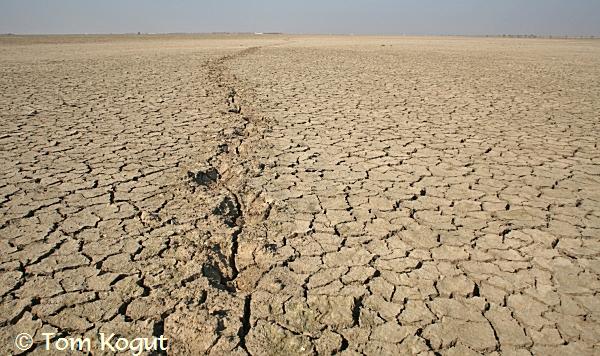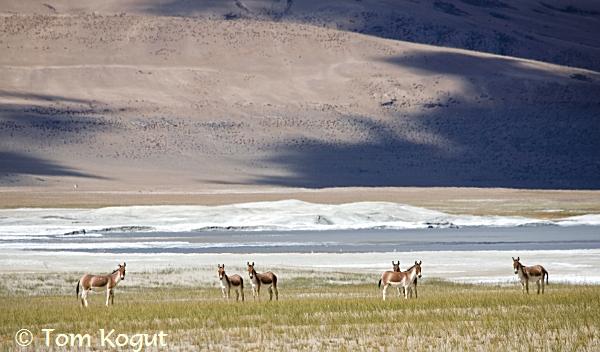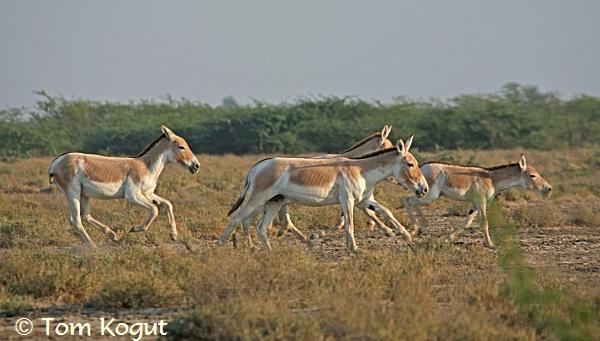|
[Editor's note: This week
we again present a special contribution--
photographs and essay -- by wildlife biologist and
photographer Tom Kogut.]
Explanation: It is June on the salt flats of the Little Rann of Kutch in the western
Indian state of Gujarat, and the temperature is approaching 122 degrees
Fahrenheit (50 degrees Celsius).
Most animals have retreated to burrows in the
ground, but the Khur or Indian Wild Ass (Equus hemonius khur), a subspecies of
the Asiatic Wild Ass, has nowhere to go ... but is somehow able to brave the
intense heat by seeking shade in patches of shrubby habitat on the edges of
the barren Rann.

Who passed by
here?
These are tracks of Khur (Indian wild Ass) in the dried mud flats
of the Little Rann of Kutch in Gujarat.
Photo taken in the dry (pre-monsoon) season.
Meanwhile, 750 miles to the northeast at Tso Kar ("salty lake" in
the local language) in the northern Indian region of Ladakh, a similar species
-- the Kiang or Tibetan Wild Ass (Equus kiang) -- is having a much easier time
of it. Tso Kar is situated at approximately 15,000 feet (4,570 m) elevation on
the Changthang Plateau, and enjoys much milder summer conditions than the
scorching salt flats of Gujarat. The challenge for the Kiangs will come during
winter when temperatures will plummet to -22 degrees Fahrenheit (-30 degrees
Celsius) and it becomes a struggle to find sufficient forage.

That's not snow ... it is salt, evaporated and concentrated by the
high-elevation, arid climate here at the Tso Kar salt lake,
on the Changthang Plateau of Ladakh of northern
India.
This is the abode of the Kiang (or Tibetan Wild Ass).
Surely these are two of the hardiest large herbivores in the world!
Relief for the Khur will come in July when the annual monsoon arrives, and
the cracked mud of the salt flats is transformed into a shallow lake. The Khur
will then wade or swim to slightly elevated islands of habitat called "bets,"
where they feed on fresh, green vegetation. They also raid crops at night,
which brings them into conflict with local farmers.
Both the Khur and the Kiang are able to digest coarse vegetation, some of which has a high saline
content, that could
not sustain other herbivores. Therefore, access to fresh water is essential for both species.
The Khur now occur only on the Little and Great Ranns of Gujarat.
They are a
threatened species, although their numbers have expanded recently to a total of
approximately 4,000 animals.
The Kiang, however, reaches the southern limit of
its range in northern India, with much larger numbers present on the Tibetan
Plateau to the north where they share their grassland habitat with Tibetan
Gazelles and Wild Yaks.
Both species face numerous threats to their continued survival, including
competition with livestock, industrial salt extraction, invasive plants such
as mesquite (Proposis juliflora), and diversion of fresh water for
agriculture.

Khur (shown here), as with Kiang, are facing a struggle and a race for
survival.
Information:
Menon, Vivek. 2003. A Field Guide to Indian Mammals. Dorling Kindersley
(India) Pvt. Ltd. 201 pp.
Monga, Sunjoy. 2002. Wildlife Reserves of India. India Book House Pvt. Ltd.
152 pp.
Schaller,
George B. 1998. Wildlife of the Tibetan Steppe. University of Chicago Press.
374 pp.
|
Index |
Location | Search | About EPOW | ... Next >